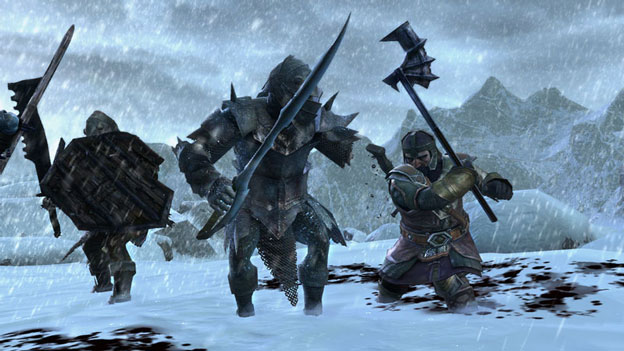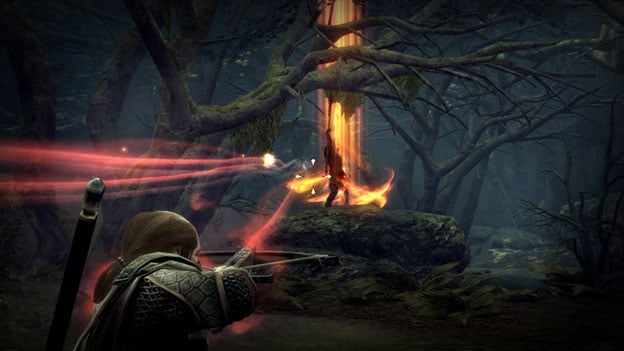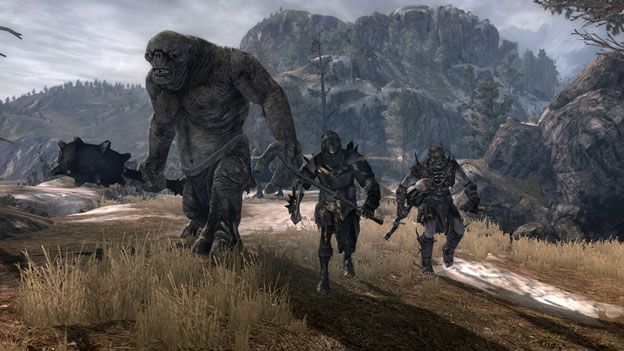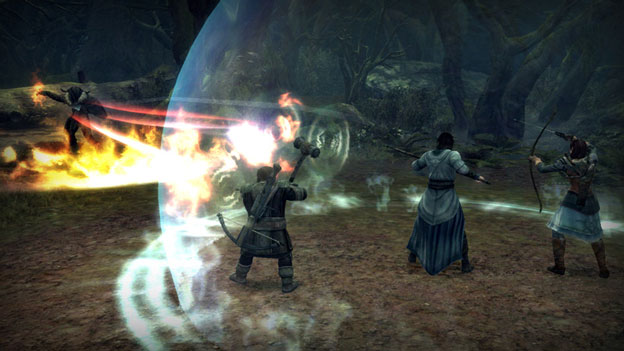The Lord Of The Rings Gets Decapitated
I love The Lord of the Rings . The books are among my favorite works of literature, and the Peter Jackson films have become a once-a-year ritual for me. In fact, I’m a little embarrassed to admit it, but I can speak a few choice phrases in both Elvish and Dwarvish. ( Mae Govannen to my fellow Tolkien geeks.) I thought it was pretty safe to assume that I was the target demographic for The Lord of the Rings: War in the North.
I was dead wrong.
Instead, it seems that Snowblind has a different audience in mind: those who have seen Peter Jackson’s films and said, “Remember that part where Aragron cuts the head off that scary dude with the bow and arrows? There should have been more stuff like that in the movies.”

You see, War in the North takes pride in the fact that it’s the first ever M-rated Lord of the Rings game. It allows players to kill orcs with more gratuitous violence than they’ve ever been allowed before. The thinking behind this was that war is dark and vile, and the M rating finally gives Snowblind the license to actually show that side of the War of the Ring. However, Mr. Tolkien was a veteran himself, seeing combat in World War I, and his stories specifically and intentionally focus on the glimmers of hope rather than the overwhelming darkness that surrounds them. In my opinion, War of the North’s fascination with violence is something of a disservice to the works it draws inspiration from.
Either way, you will spend your time in War in the North chopping orcs into several pieces and watching their black blood stain the landscape. There are three characters to select from here: Eraden, a Dúnedain Ranger; Farin, a Dwarven champion; and Andriel, an Elvin loremaster. You will choose one to play as, and the other two will be your companions, either controlled by A.I. or other players à la Left 4 Dead. Now, players are allowed a fair amount of customization with whichever character they choose—hair color and style, eye color, etc.—but this customization isn’t available from the get-go. Instead, you’ll have to seek out a mirror in the game, which will allow you to change your character’s appearance. That means you’ll spend a bit of time playing as the stock character models before you’re ever given the option to customize your look. This feels completely counterintuitive, and I see absolutely no reason this option isn’t available the second you pick a character from the start menu.
And this isn’t the only thing that feels counterintuitive. The menu system is completely awful. It does what it needs to, for the most part, but unlike pretty much every other RPG ever made, the menu has no consistent button layout. You’re asked to “confirm” any of your menu choices before they are applied; in some cases, you need to hit the X button (PS3) to confirm your choice, in others you’ll need to use the Start button, and in one specific case you’ll need to use the square button. Why there’s not one single button that you can consistently use to confirm your menu selections is completely beyond me. It seems almost like each sub-section of the menu was designed by a separate person who had no communication with the other members of the design team.

But War in the North is all about the combat, and at least the in-game controls are button-mashingly smooth. However, as you progress through the game, you’ll encounter enemies with more and more health, requiring longer and longer battles. You won’t get very deep into the game before you’re facing absurd amounts of enemies with ludicrous amounts of health. And this means combat gets extremely tedious. When it takes you two or three minutes to take down a single orc, and you see a group of six of them running toward you, it’s hard to see this as anything but an inconvenience. It feels like War in the North was designed as a completely solo endeavor, and in the later stages of development all the enemies had their stats beefed up to absurd levels in order to counter the fact that there would now be three players instead of one.
And to make this tedium worse is the fact that almost every adversary you’ll be asked to slice apart is a goblin, an orc, or a troll (Uruk-Hai show up in the later portions of the game.) Eventually, you’ll fight armored versions of these baddies, which is pretty much just a poor excuse to give the enemies even more health so the battles last even longer and become even more exhausting for the players. In a few places, you’ll see a few different enemy types. For example, in Mirkwood, you’ll be thankful to finally see a group of spiders instead of the same old orcs. But even the spiders come at you in such overwhelming numbers that you’ll grow tired of them very quickly.

It almost seems like the developers knew how repetitive the game was and began intentionally tormenting their players. There’s one cutscene in which a massive fell beast attacks, and you’re elated at the possibility of finally fighting something this incredibly awesome. But then you’re rescued before you ever have the chance. A similar thing happens a little later with a warg. You’ll be excited to fight a group of these vicious wargs after seeing one in a cutscene, only to be thrown into yet another orc camp instead.
War in the North had full use of the Lord of the Rings movie license, and thus the visual elements draw heavily from the films. Even the characters look just how they did in the films; Elrond is Hugo Weaving, Aragorn is Viggo Mortensen, and Arwyn is Liv Tyler (sort of.) However, this makes it incredibly awkward when the voice actors sound nothing like their film version counterparts. To make things worse, too often the dialogue is buried in digital reverb and echo effects to the point of sounding almost robotic. Oh yes, and the words aren’t synched with the characters’ lips very well, which can be additionally off-putting.
And though many of the landscapes look great—seeing the Barrow-Downs for the first time is incredible, as is descending into the orc-infested halls of Mount Gundabad—there are visual glitches everywhere, pretty much killing the experience. I played the PS3 version of the game and experienced several places where the animations got choppy to the point that it felt like I was playing a PC game on an incredibly underpowered system. The worst offenders happened during outdoors scenes when it was snowing; perhaps the detailed snow, when coupled with the large quantity of orcs and trolls, was a bit too much of a strain on the PS3’s processor.

Audio was a bit glitchy as well. There was one scene in particular where a sound of a chain on a pulley system got stuck in an infinite loop, increasing in volume until it drowned out everything else in the game. I had to restart the game in order to fix it (and give my poor ears a rest.) A similar thing happened with some warg howls later in the game; the audio got stuck on a loop and required a restart before the wargs would stop their obnoxious yowling.
War in the North had enormous amounts of potential with the Lord of the Rings license. The fact that it wasn’t set to correspond with any film release meant that the development team had a little more leeway to stretch their legs and make a product superior in to any generic movie tie-in. However, it feels like the developers grinned like giddy schoolchildren after acquiring the license, then just couldn’t think of anything at all to do with it. War in the North could have succeeded if it had a decent story, some interesting characters, a deep Diablo-esque loot system, epic boss battles, or even some decent enemy variety. It has not a single one of these things.
The game shares a launch month with two of the highest profile RPGs of this console generation (Skyrim and Skyward Sword), and is here only a month after The Lord of the Rings Online released a major expansion that took players to iconic Isengard. Considering the games it’s contending with right now, War in the North doesn’t even deserve to be on your radar.
RATING OUT OF 5 RATING DESCRIPTION 3.2 Graphics
Some of the backgrounds look great, but creepy character faces, choppy animations, and a long list of visual glitches hider the experience. 3.5 Control
Decent hack-and-slash controls, but navigating menus is incredibly counterintuitive. 2.3 Music / Sound FX / Voice Acting
Forgettable music, glitchy sound effects, and weak voice acting with poor use of reverb and echo effects. 2.2 Play Value
There’s a fair amount of content here, but it’s tedious and repetitive enough that you won’t want to play it for very long. 2.6 Overall Rating – Average
Not an average. See Rating legend below for a final score breakdown.
| Review Rating Legend | |||
|---|---|---|---|
| 0.1 – 1.9 = Avoid | 2.5 – 2.9 = Average | 3.5 – 3.9 = Good | 4.5 – 4.9 = Must Buy |
| 2.0 – 2.4 = Poor | 3.0 – 3.4 = Fair | 4.0 – 4.4 = Great | 5.0 = The Best |
Game Features:
